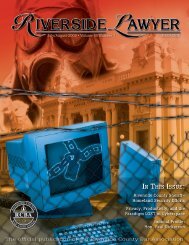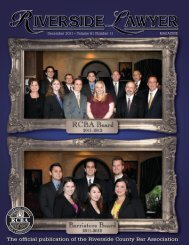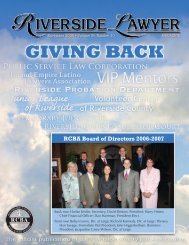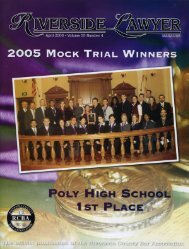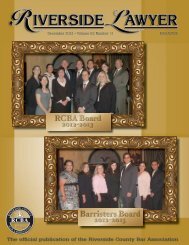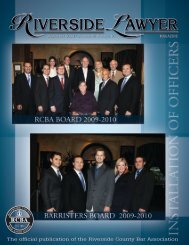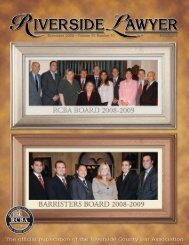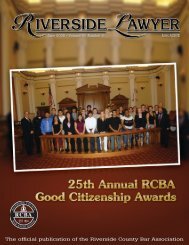THE JOHN GABBERT GALLERY - Riverside County Bar Association
THE JOHN GABBERT GALLERY - Riverside County Bar Association
THE JOHN GABBERT GALLERY - Riverside County Bar Association
You also want an ePaper? Increase the reach of your titles
YUMPU automatically turns print PDFs into web optimized ePapers that Google loves.
International Intellectual Property Conventions<br />
by Michael H. Trenholm and John W. Holcomb<br />
As the world economy has become increasingly<br />
intertwined and interdependent over the past few decades,<br />
the international community has adopted various intellectual<br />
property law conventions to facilitate IP owners’<br />
acquisition of corresponding IP rights in multiple foreign<br />
countries. Much recent discussion, especially in the<br />
U.S., has focused on the need for, and the desirability of,<br />
harmonizing disparate national laws relating to patents,<br />
copyrights, and trademarks. If full harmonization of<br />
existing national IP laws is the objective, then the current<br />
system falls far short.<br />
To provide some background, the term “intellectual<br />
property” (or “IP”) refers generally to rights granted<br />
or acknowledged by a government that provide some<br />
sort of limited monopoly power to the holder of those<br />
rights. Patents, copyrights, and trademarks are common<br />
types of IP. Patents protect new and useful inventions,<br />
or improvements to old inventions, such as the better<br />
mousetrap. A design patent, or an industrial design, is<br />
one particular type of patent that protects the unique<br />
ornamental appearance of an object. Trademarks generally<br />
protect words, slogans, and logos that designate the<br />
origin of a product or service. Copyrights protect artistic<br />
or creative expression that is fixed in some medium, such<br />
as written manuscripts, artwork, music recordings, and<br />
architectural drawings. The international conventions<br />
that relate to each of these different types of intellectual<br />
property rights are briefly described below.<br />
With respect to patent and trademark rights, most<br />
of the world’s significant industrialized countries have<br />
signed onto the Paris Convention for the Protection of<br />
Industrial Property. The Paris Convention originated<br />
in the late 1800s, and it has been modified numerous<br />
times in the past century. The Paris Convention essentially<br />
allows a person who has filed a patent or trademark<br />
application in one member country to file a corresponding<br />
application in another member country and establish<br />
an effective filing date for the corresponding application<br />
equivalent to the date of the original application.<br />
IP owners seeking the benefits of the Paris Convention<br />
must adhere to certain time deadlines. Specifically, to<br />
claim the benefits of the Paris Convention for a utility<br />
patent, the IP owner must file its corresponding application<br />
within one year of the original filing date; for design<br />
patents and trademarks, the IP owner must file its corresponding<br />
application within six months of the original<br />
application.<br />
The benefits conferred by the Paris Convention relate<br />
to the substantive national patent or trademark laws of<br />
different member countries. For example, many industrialized<br />
countries, including Japan and the countries of<br />
the European Union, require an IP owner to file its patent<br />
application before it publicly discloses its invention<br />
anywhere in the world. Without the Paris Convention,<br />
patent applicants would have to file all of their patent<br />
applications throughout the world before they commercialized<br />
their inventions, which, of course, would be costprohibitive.<br />
The Paris Convention alleviates this problem<br />
by allowing IP owners to file their applications in only one<br />
convention country, and then complete their filings in<br />
other countries up to six months or a year later.<br />
Thus, while the Paris Convention facilitates the filing<br />
of patents and trademarks in multiple countries, it is<br />
largely a procedural tool because it does not address each<br />
member country’s substantive laws relating to patents<br />
and trademarks. Hence, IP owners must comply with the<br />
various formal and substantive legal requirements of each<br />
of the countries in which they seek IP protection.<br />
An example of the disparity in substantive patent and<br />
trademark law is evidenced by the way different countries<br />
determine who among competing applicants is entitled<br />
to a particular patent or trademark. In most European<br />
countries and in Japan, the first entity to file the patent<br />
or trademark application is entitled to the resulting intellectual<br />
property right. However, in the United States, the<br />
person entitled to a patent or trademark is more often the<br />
entity that can establish that it either first invented the<br />
subject matter of the patent or first used the trademark<br />
in public. Another example of the difference between the<br />
substantive laws of different countries relates to the type of<br />
subject matter that can be patented. In the United States,<br />
one can obtain a patent on a unique method of treating<br />
medical patients; however, in many European countries,<br />
methods of medical treatment are not patentable.<br />
The discrepancy between the substantive laws of different<br />
countries has led to many calls for treaties that<br />
would harmonize those laws. Such harmonization has<br />
occurred on a regional basis in some places of the world.<br />
For example, the European Patent Office will examine pat-<br />
14 <strong>Riverside</strong> Lawyer, September 2006





